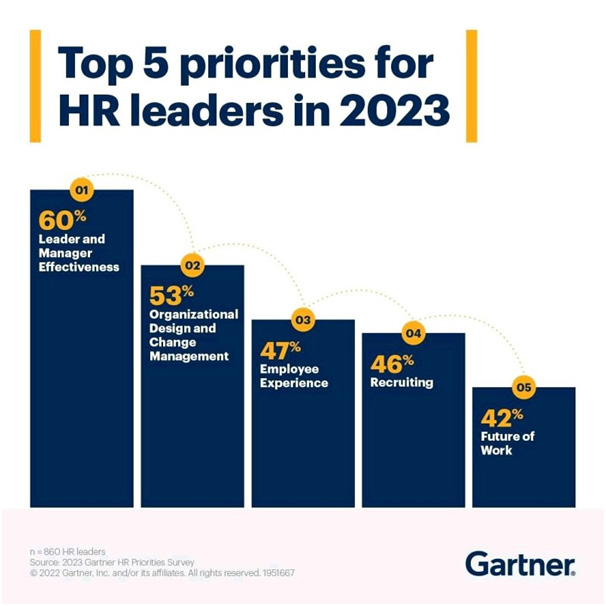To help HR leaders better manage and lead during these times, Gartner conducted an annual survey of more than 800 HR leaders and identified the top 5 priorities for HR in 2023. Top of the list is leader and manager effectiveness, but many HR leaders will also prioritize change management, employee experience, recruiting and future of work.
The top 5 priorities for HR in 2023
HR leaders must manage investments in people and technology, cultivate a positive culture and employee experience, and transform HR to be more automated and digital — all while new employee expectations are impacting retention and attraction. But their survey responses reveal their top priorities are as follows.

1: Leader and manager effectiveness
This is a priority for 60% of HR leaders, and 24% say their leadership development approach does not prepare leaders for the future of work.
As organizations and society evolve, so do the expectations for what leaders are responsible for, making their roles increasingly complex. Today’s work environment requires leaders to be more authentic, empathetic and adaptive. These three imperatives represent a new call for leadership: “human” leadership.
Also read: Navneeth Sulakhe joins Innoviti as Senior VP Human Resource Management
Even though HR leaders try to build commitment, courage and confidence in leaders to help them answer the call, human leaders remain few and far between. Leaders do need commitment, courage and confidence to be effective human leaders; however, HR’s typical approaches do not address the barriers that are holding leaders back. These obstacles include their own (very human) emotions of doubt, fear and uncertainty.
To help leaders deliver on the need for human leadership and prepare them for the future of work, recognize their humanity and directly address these emotional barriers.
2: Organizational design and change management
This is a top priority for 53% of HR leaders, and 45% say their employees are fatigued from all the change.
Digital transformations, economic uncertainty and political tensions have led to much disruption and change. As such, organizational design and change management remain a top priority for CHROs, especially now, as organizations are seeing the fallout of too much change and uncertainty.
Employees are also growing more resistant to change — in 2016, the Gartner Workforce Change Survey showed 74% of employees were willing to change work behaviors to support organizational changes, but that number dropped to 38% in 2022.
Change fatigue has clear ramifications. HR leaders must help employees to navigate change and mitigate the impact that change may have on their work and, more importantly, their well-being.
3: Employee experience
This is a top priority for 47% of HR leaders, and 44% believe their organizations do not have compelling career paths.
Many HR leaders struggle to identify the internal moves that employees must make to grow their careers. In a recent Gartner survey on employee career preferences, just 1 in 4 employees voiced confidence about their career at their organization, and three out of four looking for a new role are interested in external positions.
Typically, career development follows three steps:
- Set a trajectory and communicate role benefits and requirements.
- Find in-role opportunities for potential new roles.
- Identify internal roles to achieve goals.
However, that pathway is less clear now that work experience is changing. Career options are less visible with less time in offices; current skills are becoming obsolete and employees aren’t prepared for future roles, and current options don’t satisfy employee needs as people rethink the role of work in their life. This presents new career imperatives for HR leaders to create best-fit careers for employees.
4: Recruiting
This is a top priority for 46% of HR leaders, and 36% say their sourcing strategies are insufficient for finding the skills they need.
Fifty percent of organizations still expect the competition for talent to increase significantly in the next six months, regardless of broader macroeconomic conditions.
This means recruiting leaders must reprioritize recruiting strategies to align with current business needs, plan for multiple potential scenarios in this shifting market and make decisions with great confidence using data.
Focus on three strategies to support strong talent and business outcomes in today’s market:
- Build an intelligence-based sourcing capability.
- Create an equitable internal labor market.
- Build onboarding for engagement.
5: Future of work
This is a top priority for 42% of HR leaders, and 43% say they do not have an explicit future of work strategy.
The “future of work” continues to be synonymous with a remote and hybrid workforce. But while this shift is a seismic change for many organizations, it is only part of the equation. Workforce planning — anticipating future talent needs — is at the epicenter of a future of work strategy and is a top priority for HR leaders. But today’s workforce planning is disconnected from reality and current strategies are ineffective at combating the disruptive landscape. Think: shifting skills, scarce talent, high turnover and a shift in the employee-employer dynamic.
Instead of assuming we can predict future skills needs, access enough talent, fill future gaps by buying and building, and dictate when and where employees work, we need a new approach that unlocks new strategies.
Stay connected with us on social media platform for instant update click here to join our LinkedIn, Twitter & Facebook



































Add comment